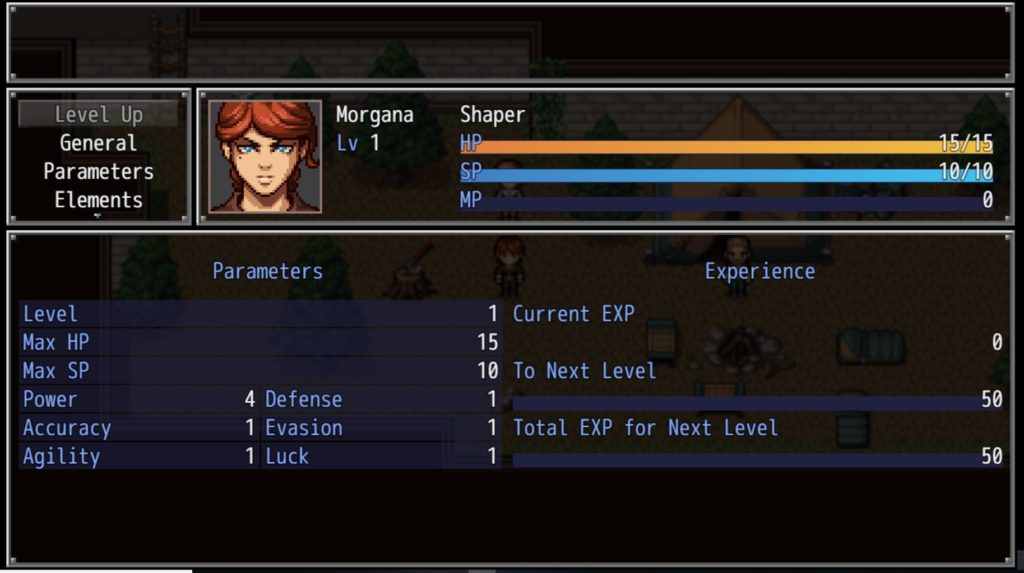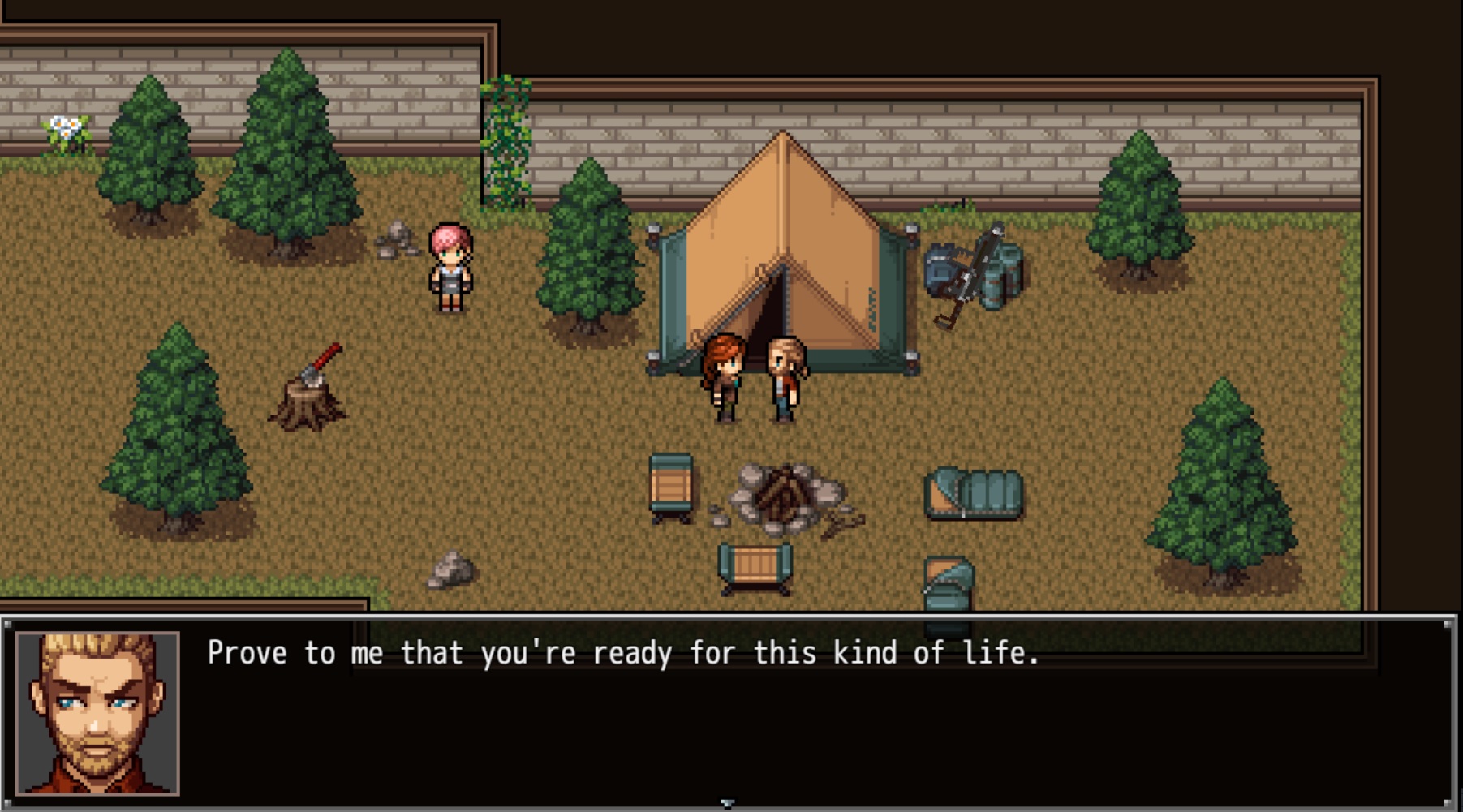The Memory RPG System covers both the combat mechanics and character progression for A Memory of Eternity Games, inspired by classic JRPGs and tabletop RPGs. This system uses turn-based, tactical grid combat as well as class-based leveling. In this post, we’ll cover the classes, subclasses, stats and character leveling.
From a design standpoint, the Memory RPG System is intended to be easy to understand, fun to use, and still provide relative depth. However, as a novice gamemaker, I’m sure I’ll run into some issues that will need to be ironed out later. The backbone of the system is character progression with a softcap of 30 levels that players can achieve. Beyond level 30 characters will no longer have the chance to upgrade talents, class features or learn new skills, but they will still be able to increase base stats.
Curious to what games I’m using this on? Here is the development roadmap.
Classes
Each character in AMOE games will have at least one class, with the ability to dualclass into another if they wish, or deepen their investment in their primary class with Class Expertise and Class Mastery.
The four basic classes so far are:
- Soldier – A hard-hitting and durable class that is suitable for frontline and midline. Soldiers can equip and use the heaviest of armor and the most devastating of weapons. Their role in combat is to draw fire away from more vulnerable party members and also deal impressive damage in their own right.
- Shaper – One of the rare individuals in the world of AMOE who can shape Inara, or memory magic. They can only use light armor and weapons, so they rely mostly on their precarious – and often self-destructive – magic. Shapers can use this power to shape the battlefield, disorientate their enemies, and even focus it into physical attacks. Their role in combat is primarily battlefield control, but they can also serve as artillery or hold their own in melee combat.
- Vigilante – This class is drawn from the vigilantes, vagrants and thieves of MoonFall. They are surprisingly agile and are best used as melee assassins or snipers. Vigilantes can only use medium armor and weapons, so they lack the solidity of the Soldier or the magical defenses of the Shaper. Hit-and-run tactics or shots from the backline work best for vigilantes.
- Support – Combat is lethal in AMOE, so the support class is invaluable, being able to provide healing and buffs/debuffs as needed. Weak in dealing direct damage, the support class can still hold its own with medium armor and medium weapons. They are best used in the midline or backline, applying heals to the party and making the best use of their ranged attacks.
Specializations
Each class will have at least two specializations that will further define the character’s combat role and add new skills.
Soldier
- Frontline Juggernaut – skills and abilities that enhance the Soldier’s ability to tank damage and increase melee damage. Powerful Aura skills can boost allies and hinder enemies.
- Heavy Artillery – skills that allow a character to bombard enemies from a distance and AOE effects.
Shaper
- Path of the Ethereal Fist – skills that allow a shaper to stay on the frontlines as long as they are dealing damage.
- Reality Tearer – skills that create damaging obstacles or throw enemies around the battlefield.
- Memory Weaver – skills that disorient the enemy, make them attack their allies, and the creation of illusions.
Vigilante
- Shadow Assassin – skills that give the user high mobility and lethal single-target damage.
- Death from Afar – skills that emphasize long range attacks and deployables like mines and turrets.
Support
- Battle Saint – skills that increase a user’s attack capabilities, new melee capabilities and damaging Auras.
- Beacon of Hope – skills that increase the healing potential and utility of the Support class.
Dualclassing
Characters have the option to take on another class at later levels, and even eventually get a specialization for their second class.
Class Expertise and Mastery
Characters who decide not to dualclass have the option to increase their expertise in their primary class. At the same level characters have the option to choose a second class, they can take Class Expertise and gain additional skills and abilities. At the same level a character would take on a second specialization, they can take Class Mastery, further providing skills and benefits related to their primary class. The general idea is that dualclassing provides more utility and flexibility, but Class Expertise/Mastery increases overall power in a single role.
Leveling

A very, very early version of the status menu.
Characters gain experience by engaging in combat or being present during certain events. Experience can also be a reward for completing missions. At the start of AMOE games, all characters start at level 1, despite perhaps having previous experience as a soldier or vigilante. This is to reflect the divide from their previous experiences and their now heightened state of danger.
Once a character has enough experience, they can level up manually, distributing stat upgrades, learning new skills and talents, and choosing specializations and possibly a second class.
Stats
There are currently 6 primary stats:
- Power – Determines how much damage the character deals in attacks.
- Defense – Determines how much damage the character takes from attacks.
- Accuracy – Determines the character’s ability to land attacks.
- Evasion – Determines the character’s ability to evade attacks.
- Agility – Determines when the character takes its turn in battle and movement points.
- Luck – Determines the rate of random occurrences, loot drops, critical hits and how likely a status effect will succeed.
And two conditions:
- Health Points – this represents the individual’s constitution and will to live. When it reaches 0, that character dies or falls unconscious.
- Special Points – this represents the individual’s will to fight. Many skills require SP to use, and if SP reaches 0, the character cannot use those skills until it is restored.
Any of these can be raised during a level up, but be aware – characters only get so many upgrade points per level.
Talents
Not everything in AMOE revolves around combat, and occasionally characters will find themselves resolving an encounter in another way rather than brute force. Whether it’s hacking a electronic lock, trying to lift an obstacle out of your path, finding traps or trying to talk your way out of trouble, Talents are the backbone behind non-combat encounters.
There are currently four talents:
- Athletics – How fit your characters are. Characters with a high Athletics score can lift heavier objects, leap over pits or even throw their companions to safety.
- Perception – How perceptive your characters are. A high Perception score might mean your party catches a pickpocket, finds traps more easily, or notices that they are being tailed.
- Technology – How tech savvy your characters are. AMOE is a high-tech setting, and being knowledgeable about technology means your characters can better manipulate – or sabotage – electronic devices.
- Charisma – How charismatic your characters are. Want to talk an enemy down or lower the prices from your favorite merchant? Having a high charisma is the way to go.
Skills and Class Features
Skills and Class Features are the movesets that characters learn as they level up. These can include anything from different attacks to additional movement and spells. Skills are divided into 4 tiers. Tier 1 skills are basic moves available to all characters in that class, while Tier 2 and 3 skills are restricted to a specialization. Tier 4 skills are powerful moves that are only accessible by high-level characters.
Additionally, there are Momentum skills that characters can learn. Momentum skills need to be charged either by dealing damage to enemies, or receiving damage, which is reflected in an increase in Momentum Points. Momentum skills are very powerful and capable of turning around a fight when used, but are usually only accessible towards the end of a battle.
Turn Economy
Turns are divided into free actions and full actions. Characters can use free actions at will (until that skill goes into cooldown or they run out of resources to power that skill). Full actions, however, can only be taken once.
What counts as a free action?
- Moving (up to a character’s move speed limit)
- Inspect
- Skills and class features with the “free action” status
What counts as a full action?
- Using a skill or class feature without the “free action” status
- Using an item
This results in free actions being very, very powerful since it allows a character to do multiple things per turn. However, skills and class features that are free actions typically are either weaker, can only be used sparingly, or have high costs to use.
Detailed leveling table:
1: Class base stats and features, choice of two Tier 1 skills, first talent point, 1st Momentum skill
2: 3x stat increase, Tier 1 ability
3: 3x stat increase, talent increase
4: 3x stat increase,
5: 3x stat increase, Tier 1 ability
6: 3x stat increase, talent increase
7: 3x stat increase, can choose class specialization
8: 3x stat increase, Tier 2 ability
9: 3x stat increase, talent increase
10: 3x stat increase, 2nd Momentum,
11: 3x stat increase
12: 3x stat increase, talent increase, Tier 2 ability
13: 3x stat increase
14: 3x stat increase, can choose second class (pick two Tier 1 abilities) or Class Expert
15: 3x stat increase, talent increase,
16: 3x stat increase, Tier 3 ability
17: 3x stat increase
18: 3x stat increase, talent increase
19: 3x stat increase
20: 3x stat increase, Tier 3 ability, 3rd Momentum
21: 3x stat increase, talent increase, can choose second class specialization (pick two Tier 2 abilities) or Class Mastery
22: 3x stat increase
23: 3x stat increase
24: 3x stat increase, talent increase, Tier 4 ability
25: 3x stat increase,
26: 3x stat increase
27: 3x stat increase, talent increase
28: 3x stat increase, Tier 4 ability
29: 3x stat increase
30: 3x stat increase, talent increase, 4th Momentum
Curious to what games I’m using this on? Here is the development roadmap.

Comments are closed